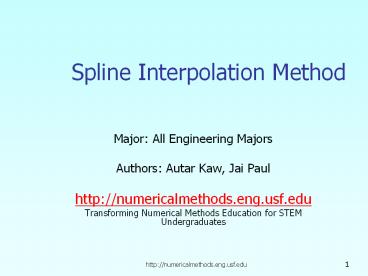Spline Interpolation Method - PowerPoint PPT Presentation
Title:
Spline Interpolation Method
Description:
A power point presentation to show how the Spline method of interpolation works. – PowerPoint PPT presentation
Number of Views:273
Avg rating:3.0/5.0
Title: Spline Interpolation Method
1
Spline Interpolation Method
- Major All Engineering Majors
- Authors Autar Kaw, Jai Paul
- http//numericalmethods.eng.usf.edu
- Transforming Numerical Methods Education for STEM
Undergraduates
2
Spline Method of Interpolation
http//numericalmethods.eng.usf.edu
3
What is Interpolation ?
Given (x0,y0), (x1,y1), (xn,yn), find the
value of y at a value of x that is not given.
4
Interpolants
- Polynomials are the most common choice of
interpolants because they are easy to - Evaluate
- Differentiate, and
- Integrate.
5
Rocket Example Results
t (s) v (m/s)
0 0
10 227.04
15 362.78
20 517.35
22.5 602.97
30 901.67
Polynomial Order Velocity at t16 in m/s Absolute Relative Approximate Error Least Number of Significant Digits Correct
1 393.69 -------------
2 392.19 0.38 2
3 392.05 0.036 3
4 392.07 0.0051 3
5 392.06 0.0026 4
6
Why Splines ?
7
Why Splines ?
Figure Higher order polynomial interpolation is
a bad idea
8
Linear Interpolation
9
Linear Interpolation (contd)
10
Example
- The upward velocity of a rocket is given as a
function of time in Table 1. Find the velocity at
t16 seconds using linear splines.
Table Velocity as a function of time
(s) (m/s)
0 0
10 227.04
15 362.78
20 517.35
22.5 602.97
30 901.67
Figure. Velocity vs. time data for the rocket
example
11
Linear Interpolation
12
Quadratic Interpolation
13
Quadratic Interpolation (contd)
14
Quadratic Splines (contd)
15
Quadratic Splines (contd)
16
Quadratic Splines (contd)
17
Quadratic Spline Example
- The upward velocity of a rocket is given as a
function of time. Using quadratic splines - Find the velocity at t16 seconds
- Find the acceleration at t16 seconds
- Find the distance covered between t11 and t16
seconds
Table Velocity as a function of time
(s) (m/s)
0 0
10 227.04
15 362.78
20 517.35
22.5 602.97
30 901.67
Figure. Velocity vs. time data for the rocket
example
18
Solution
Let us set up the equations
19
Each Spline Goes Through Two Consecutive Data
Points
20
Each Spline Goes Through Two Consecutive Data
Points
t v(t)
s m/s
0 0
10 227.04
15 362.78
20 517.35
22.5 602.97
30 901.67
21
Derivatives are Continuous at Interior Data Points
22
Derivatives are continuous at Interior Data Points
At t10
At t15
At t20
At t22.5
23
Last Equation
24
Final Set of Equations
25
Coefficients of Spline
i ai bi ci
1 0 22.704 0
2 0.8888 4.928 88.88
3 -0.1356 35.66 -141.61
4 1.6048 -33.956 554.55
5 0.20889 28.86 -152.13
26
Quadratic Spline InterpolationPart 2 of
2http//numericalmethods.eng.usf.edu
27
Final Solution
28
Velocity at a Particular Point
- a) Velocity at t16
29
Acceleration from Velocity Profile
- b) The quadratic spline valid at t16 is given by
30
Distance from Velocity Profile
- c) Find the distance covered by the rocket from
t11s to t16s.
31
Additional Resources
- For all resources on this topic such as digital
audiovisual lectures, primers, textbook chapters,
multiple-choice tests, worksheets in MATLAB,
MATHEMATICA, MathCad and MAPLE, blogs, related
physical problems, please visit - http//numericalmethods.eng.usf.edu/topics/spline
_method.html
32
- THE END
- http//numericalmethods.eng.usf.edu































